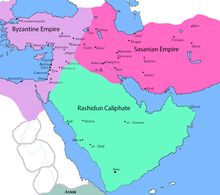| Arab conquest of Mesopotamia | |||||||||
|---|---|---|---|---|---|---|---|---|---|
| Part of the Muslim conquest of Persia | |||||||||
 Map of Iran (Persia) and its surrounding regions on the eve of the Muslim invasions | |||||||||
| |||||||||
The Arab conquest of Mesopotamia was carried out by the Rashidun Caliphate from 633 to 638 AD. The Arab Muslim forces of Caliph Umar first attacked Sasanian territory in 633, when Khalid ibn al-Walid invaded Mesopotamia (then known as the Sasanian province of Asōristān; roughly corresponding to modern-day Iraq), which was the political and economic centre of the Sasanian state.[1] From 634 to 636 AD, following the transfer of Khalid to the Byzantine front in the Levant, the hold of Arab forces on the region weakened under the pressure of Sasanian counterattacks. A second major Arab offensive in 636 and ended in January 638 with the capture of Mosul and the consolidation of Arab control over and exclusion of Sasanid influence from the whole Mosul-Tikrit region.
- ^ Stephen Humphreys, R. (January 1999). Between Memory and Desire. University of California Press. p. 180. ISBN 9780520214118 – via Internet Archive.
© MMXXIII Rich X Search. We shall prevail. All rights reserved. Rich X Search
